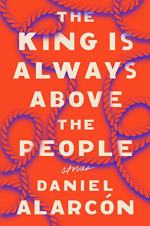|
This section contains 734 words (approx. 2 pages at 400 words per page) |

|
The King Is Always Above the People Summary & Study Guide Description
The King Is Always Above the People Summary & Study Guide includes comprehensive information and analysis to help you understand the book. This study guide contains the following sections:
This detailed literature summary also contains Quotes and a Free Quiz on The King Is Always Above the People by Daniel Alarcón.
The following version of this book was used to create this study guide: Daniel Alarcón. The King Is Always Above the People. Riverhead, 2017. Hardcover.
The collection consists of ten short stories. The first story, “The Thousands,” details how a group of migrants comes upon a fallow piece of land, on which they build a settlement out of found and scavenged materials. When government forces arrive to drive them out, the residents successfully defend their community.
In the second story, “The Ballad of Rocky Rontal,” a young man who grows up in socially and economically disadvantaged circumstances spends 32 years in prison for a gang-related murder. After he gets out of prison, Rocky is faced with the choice of whether to avenge the rape and murder of his younger sister. The story ends with him standing on a roof with a rifle, trying to decide whether to shoot the man who perpetrated the crime.
In the third story, “The King Is Always Above the People,” a young man from the provinces moves to the capital with hopes of finding adventure. When his girlfriend from back home reveals that she is pregnant, however, he is forced to return to his hometown. However, with the blessing and promise of support from his father, it is implied that he ventures back out again at the end of the story.
The fourth story, “Abraham Lincoln Has Been Shot,” has a narrator who reflects on his romantic relationship with a man named Lincoln (we do not receive confirmation that the character and the sixteenth president are one and the same) and applies it to his current troubled relationship with a man named Hank. As the story ends, Manuel abandons Hank in a car in the middle of the desert.
The fifth story, “The Provincials,” includes a narrator, Nelson, who describes his and his father, Manuel, traveling to Manuel’s hometown to handle the affairs of the narrator’s recently deceased great-uncle. While in town, they run into a group of Manuel’s old acquaintances at a restaurant. Those men eventually reveal that they resent Manuel for abandoning them to live in the capital city. Throughout the encounter, Nelson impersonates his brother, Francisco, who lives in the United States.
The sixth story is “Extinct Anatomies.” In this story, the narrator has a standing dental appointment with his cousin, who is a dentist. During the appointments, the narrator sexually fantasizes about his cousin’s assistant, and later about his cousin’s fiancée.
In “República and Grau,” the seventh story in the collection, ten-year-old Maico enters a panhandling business venture with a blind man at the titular busy intersection. After learning that Maico shows up every day neatly dressed, the blind man incites Maico’s father to beat him, so that he will look more pathetic and they will collect more money. When Maico realizes what the blind man has done, he casts their day’s earnings into the street and abandons the blind man there.
In the eighth story, “The Bridge,” the narrator’s uncle, Ramón, and his wife, Matilde – both of whom are blind – die by walking off the edge of a collapsed pedestrian overpass. The narrator is named executor of his uncle’s estate. He visits his father in an asylum for the criminally insane, and he then visits Ramón and Matilde’s house and considers moving there.
The ninth story, “The Lord Rides a Swift Cloud,” describes the narrator meeting a man named Marcial in a bar on his travels. Marcial follows the narrator home and they strike up a conversation. Marcial eventually admits that he had originally planned to rob the narrator at knifepoint. The narrator later returns to the apartment he shared with his estranged wife, from which their neighbors have looted all the furniture.
In the collection's final story “The Auroras,” Hernán arrives in a new port city, having abandoned his university professorship and his wife and stepson in the capital. He moves in with a woman named Clarisa, and he sleeps with her as well as several of her friends. At the end of the story, it is revealed that Clarisa has been charging her friends for Hernan’s sexual services. Despite his knowledge of this, Hernán remains in Clarisa’s house, even after her husband returns from sea, and continues to do his “job” (240).
Read more from the Study Guide
|
This section contains 734 words (approx. 2 pages at 400 words per page) |

|



